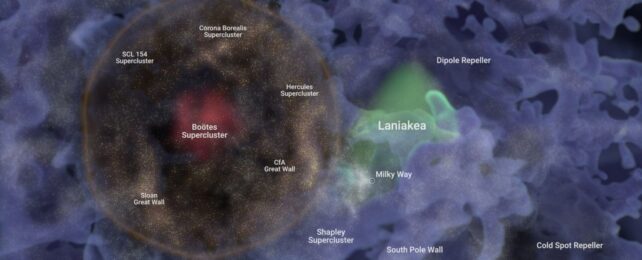An arrangement of galaxies in a giant bubble has been found not far from the Milky Way, and astronomers believe it could be a relic of the early Universe.
Astronomers have named the cluster Ho'oleilana, a Hawaiian name inspired by the chant, Kumulipo, which tells of the creation of structure in the Universe.
The cluster's characteristics suggest that it's something known as a baryon acoustic oscillation (BAO), a fossilized acoustic wave that propagated through the early Universe before freezing into place.
Such oscillations can be found throughout the Universe. But, at a distance of just 820 million light-years from the Milky Way, Ho'oleilana has astronomers gobsmacked.
"We were not looking for it. It is so huge that it spills to the edges of the sector of the sky that we were analyzing," says astronomer Brent Tully of the University of Hawai'i.
"As an enhancement in the density of galaxies it is a much stronger feature than expected. The very large diameter of one billion light years is beyond theoretical expectations. If its formation and evolution are in accordance with theory, this BAO is closer than anticipated, implying a high value for the expansion rate of the universe."
The discovery came from a catalog compiled by Tully and his colleagues, named Cosmicflows-4. The researchers measured the distances to 55,877 galaxies in a specific sector of the sky, using eight distinct methodologies for the most accurate map yet. It's only when you can work out how far away galaxies are that patterns in their density start to come together.
This is how the researchers came to see a very specific, shockingly familiar pattern: a ring, around 1 billion light-years across, in which galaxies appear more densely grouped, with a dense cluster of galaxies in the center. This is the structure of a baryon acoustic oscillation.
When the Universe was very new, it was filled with a hot, dense plasma that behaved like a fluid. The war between the inward pull of gravity against the outward pressure of radiation produced spherical acoustic waves that traveled through the plasma.
When the Universe reached an age of around 380,000 years old, it cooled enough that atoms could form from the particles that had been bouncing around loose. The outward rippling of the acoustic waves stopped and became frozen as regions of higher density in the matter that was forming, with a radius of around 150 megaparsecs, or around 490 million light-years. They're not actually rings, but spheres; they look like rings to us because of perspective.
These structures are useful for many reasons. They can help us measure cosmic distances, for instance, since we know precisely how big they are. They can also help us track the expansion of the Universe. But we can only find them if we can identify how galaxies are clustered together.
"I am the cartographer of the group, and mapping Hoʻoleilana in three dimensions helps us understand its content and relationship with its surroundings," says cosmographer Daniel Pomarede of CEA Paris-Saclay University in France.
"It was an amazing process to construct this map and see how the giant shell structure of Hoʻoleilana is composed of elements that were identified in the past as being themselves some of the largest structures of the universe."
Some of the structures that are parts of Ho'oleilana include the Boötes Void, a spherical underdensity of galaxies 400 million light years in diameter; the Coma Great Wall and the Sloan Great Wall form parts of the shell; and the Boötes Supercluster is almost dead in the center of the bubble.
Because the bubble is bigger than expected for a BAO, the discovery of Hoʻoleilana suggests that the Universe might be expanding faster than we thought. Estimates generally range between 67 and 74 kilometers per second per megaparsec; Hoʻoleilana implies an expansion rate of 76.9 kilometers per second per megaparsec.
Further observation and analysis, the researchers say, will be required to try to unravel this fascinating tangle.
The research has been published in The Astrophysical Journal.
